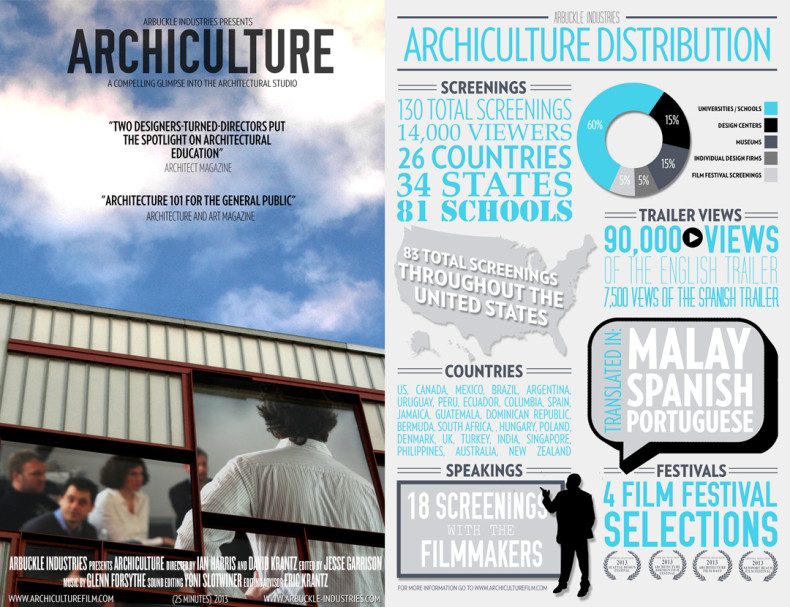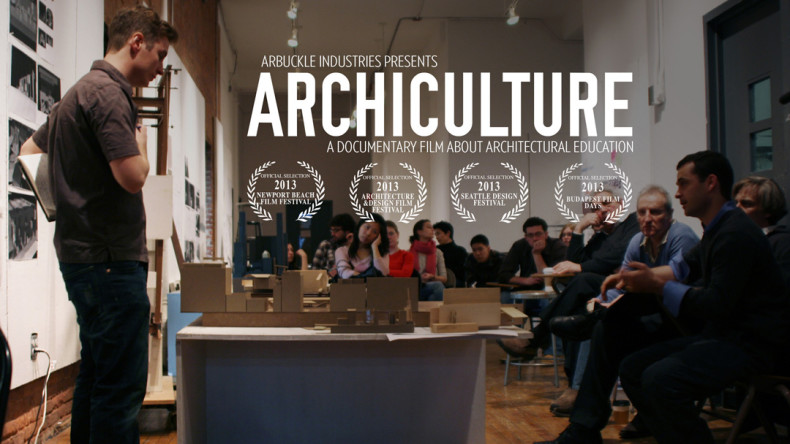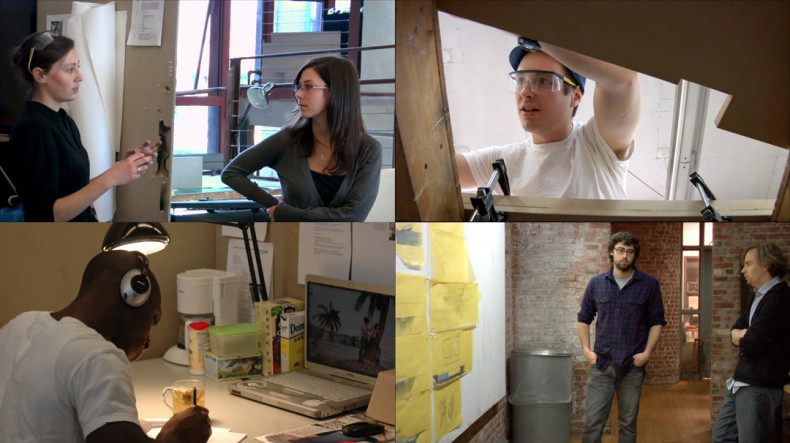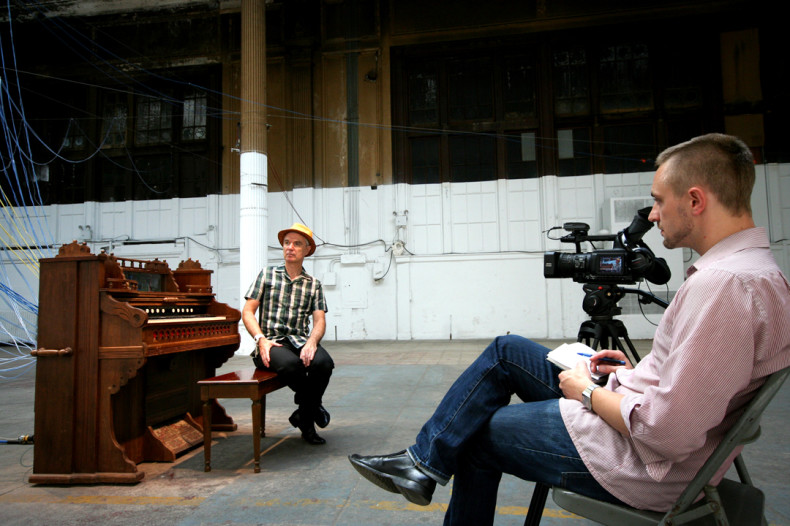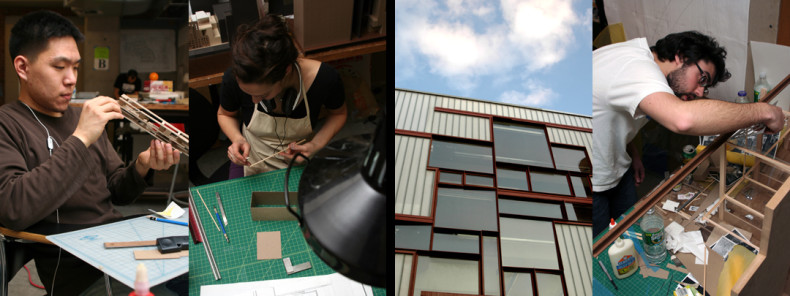Dec 16, 2014 Hello, Archiculture
Archiculture has been making the rounds at film festivals and architecture schools for a year now, and on Wednesday, December 17, it will be made available to the public via archiculturefilm.com and YouTube. The 25-minute documentary produced by Arbuckle Industries not only gives five architecture students the Spellbound or First Position treatment in an effort to shed light on the industry, the art, and the foundation that it’s built upon, but also includes interviews with the likes of Shigeru Ban (who happens to be part of Imprint’s own Architecture for Dogs) Annie Choi (Dear Architects, I am sick of your shit), and David Byrne (you know). On the eve of the online premiere, co-producer and co-director Ian Harris made time to answer some questions I had about the project.
Is your intended audience architects or non-architects? Does it offer different things to either camp?
We see our audience like a bulls-eye target or dartboard with three rings where the architects in the middle of the first core ring. On the next ring are friends, family, and others who’ve gone through a design studio or worked with architects such as engineers. And then on the last ring are those who may hold an interest in architecture but don’t know much of the profession or what it takes to become one, like high school students or someone that loves Apple products and nice buildings. This film was structured and created in a way to offer an entertaining storyline for each of them to watch and then respond, while hopefully pulling them ever closer to an interest and understanding of the profession.
Did you and your partner David Krantz have a filmmaking background going into the project?
Neither one of us had a background in filmmaking prior to Archiculture. To gain the necessary technical skills we took courses through a local production company in the Bay Area while we both worked our 50+ hour design jobs and worked on the pre-production phase of the film. It took us about a year to get the technical skills and conceptual outline locked before we could move ahead with selecting a host school.
Can you tell me how your background in architecture might have turned out to be useful to the project?
The question of how our architecture background or training has prepared us to produce a film and now run a video production company is one that came up a lot at the film screenings we attended at various universities. It is widely know in academia that close to half of those who leave architecture school do not go on to get licensed so there is definitely a larger question here, but personally I feel like the skills necessary to see an idea from a napkin sketch to a building are very similar to that of a tagline for a script to the final film. In both, the architect and filmmaker play the generalist who orchestrates a team around creating a vision. There are budgets, trades, restrictions, and moving targets to both and this is where I steel my architectural training prepared me for what I do now. I do feel like there are a lot of ways we could improve or even mildly prepare students for what it takes to practice architecture but that is another much larger discussion which can be seen through many of our recorded #Archichat discussions on our website and on the online discussion hashtag.
What are the benefits of following students instead of architects?
Students are more passionate and less reserved than a practicing architect is. Our company, Arbuckle Industries, has interviewed over 100 of the world’s leading architects and I am generally amazed at how protected they can be of the profession and opportunity for open criticism when put on camera. I think that the idea of open critiques largely disappears once the business of architecture takes over in the profession, which is a great void. It does happen at various design centers and organizations but not at the level necessary to keep the field progressive enough for what society needs today by solving tomorrow’s problems.
What is difficult to gain access to the architects that you did talk to? There are some heavy-hitters in there!
Well, the good thing about being based in New York City and having the economic implosion drag our post-production out for years we were able to lay and wait until all these amazing folks came through. Some of them have great stories, like helping David Byrne’s mom down the stairs at his Playing the Building installation and figuring that was the best time as any to ask him for an interview about architecture. There are many, many more but I don’t want to ramble.
How do folks like David Byrne, Sway Calloway, and Michael Dukakis fit in to the story you’re trying to tell?
The profession needs to step outside of itself and reflect on a bigger cultural and societal level for it to ever get into the minds and hearts of the general public. We found by putting so many architects onto camera that it was astonishingly difficult to get them to really convey what architecture means to society and how deeply embedded and empowering it can be. Problem is, most spaces in this country are never designed and most architects are focused upon keep their business sustained so we’ve been driven towards a race to the bottom. So we decided to make a concerted effort to step outside of the navel-gazing qualities of the profession and find people who could help ground it with their own personal experience, which led us to some of the folks you mention.
The trailer alludes to a “starchitect” system. Because of buildings like Gehry’s Disney Concert Hall in Los Angeles, for example, the general public is more aware of architecture than ever before. But what is the danger?
The starchitect focus of the profession and its media is definitely bad for the quality and general discourse within the profession. It does not permit enough coverage and open discussion of the great work that is happening at all levels, scales, and types. It can also be positive in some ways; someone like my mom in Ohio knows of a Frank Gehry type or a Shigeru Ban or Zaha Hadid. I think in a lot of ways the economic recession (or whatever you want to call it) along with the younger generations of architects coming of age in the profession has pulled the focus toward the quality of work from the ground up and open, cheap, instant-access communication platforms. This is another lighting rod topic that we touch on in the film and hopefully stoke a discussion about its impact and how we are training the next generation of architects and what type of future profession awaits them. We hope that the film helps empower discussion and engagement across all generations since it is rarely accomplished in the architectural field.
Find out more about Archiculture at archiculturefilm.com. The film will be available for streaming on Wednesday, December 17! And for more articles, events, and announcements, follow Imprint Culture Lab via Twitter, Instagram, and Facebook.



